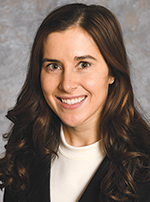|
|
I recently had the opportunity to experience the Nebraska Mission of Mercy for the first time as a dental student; wide-eyed and ready to treat patients. It was a heart pounding, new experience. Before that weekend, I was used to only treating two patients per day in a well-controlled environment. When the doors opened at 6 a.m., it was time to hit the ground running.
The topic of access to care for underserved Americans has been sprinkled into my curriculum here and there, with infographics and statistics on the number of people in America without a dental home. However, this number became more than a statistic when I was face to face with people who live in my community, are struggling to find a dental home while living in pain, and are unable to comfortably eat or go to work.
After my first day of treating patients, I left the clinic excited about how many people we were able to help that day. I felt like I had truly helped to make a difference. However, after the weekend was over and the excitement died down, I was left with a pit in my stomach.
On my drive home, I kept thinking, what is next for these patients?
Many needed follow-up care. I charted my patients just how I was taught, with a plan for a follow up appointment to treat the nonemergency care followed with recare every six months.
But I kept thinking, is there a follow-up option for them? That weekend, Mission of Mercy helped 1,000 Nebraskans alleviate dental pain and receive care, but did we help these individuals fare any better for their future? Will these same patients be back next year in a neverending cycle of emergency care? If this is the truth, was the mission simply a “band-aid” approach to addressing our nation’s access to dental care crisis?
Dental caries and periodontal disease are chronic disease models. While relieving toothaches and placing restorations treats the symptoms or restores the tooth, we will never achieve helping underserved Americans limit their risk factors until we find them dental homes.
The ADA’s policy handbook states the importance of every patient needing a dental home, and as doctors we are to improve the efforts in access to care strategies.
What can we, as a dental community, focusing on health equity, do to move oral health forward?
The Mission of Mercy brings together thousands of dentists and other oral health care providers in an effort to help members of their community alleviate dental pain. According to the Dentists Care Foundation — who oversees MOM projects nationwide — there were over 30 MOM events in 2019, six in 2020 (because of the pandemic), 17 in 2021 and over 20 events are anticipated for 2022. Millions of underserved patients receive significant care at MOM events each year which greatly assists a reduction of dental visits to hospital emergency departments.
However, the help simply stops there.
One solution for working towards a better and more sustainable oral health care future for underserved individuals is an additive public health initiative. In the MOM setting, we have direct contact with people without a dental home, and we can connect them to one before they leave.
A dental home could be a community health center, federally qualified health center FQHC, providers that accept Medicaid or provide care based on a sliding scale, or discounted dental care such as dental schools.
Additionally, there can be government agencies available to help individuals sign up for assistance programs such as food insecurity, housing needs, and job training services. Some of these are government programs and others are nonprofits and community-based.
I challenge the mission of mercy organizers, ADA leaders, and state dental association leaders to set a goal of connecting patients to a dental home. The infrastructure of having caring dentists in one location is already established, the capability of implementing the public health initiative is just a step away.
At the next MOM planning session, invite your local government agencies and nonprofits. Open the door and explore the possibilities of how your state mission of mercy can partner with these organizations.
Keep in mind the importance of preventative oral health care in a dental home rather than the emergency “band-aid” approach to set up your community members for better oral health / overall health care outcomes.
Not only are we helping the underserved to find a sustainable place for dental care, but we alleviate the pressure and money spent on one-appointment fixes that don’t address the root cause of the problem. If MOM events could even help 10% of its patients find a dental home each year, by 10 years we could have found a dental home for thousands of Americans.
I would like to commend all MOM organizers and volunteers for dedicating their time and putting forth the effort to help organize such a great event that helps so many individuals. We see the gratitude and relief on patient faces when they are no longer living with agonizing dental pain for the first time in months, or have the largest grin when they get their new dentures and can eat their favorite foods again.
We all make a difference in these two days. Imagine the difference we can make finding them a dental home and establishing preventative and periodic oral health care. We change the outlook from fixing teeth, to changing lives.
Ms. Pankratz is a third-year dental student at the University of Nebraska Medical Center College of Dentistry.
 Sophia Pankratz
Sophia Pankratz